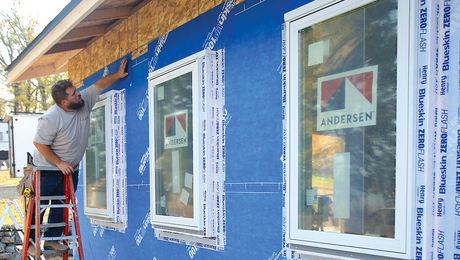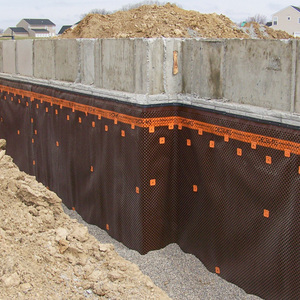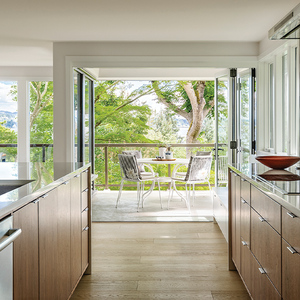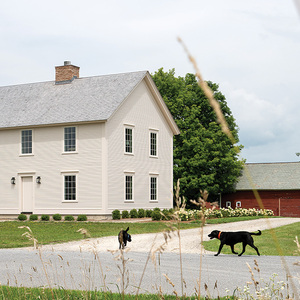I recently built a roof over a deck. The roof is in the middle of a two story house. The rafters at a 4 on 12 pitch are nailed onto a box beam and the ceiling joists do the same about 2′ lower. The architect directed me to install a strip vent at the ends of the rafters but did not see the need for venting the top of the roof. Simply stated, he allowed a means of access for the air but not a means of egress. The problem is that in the two feet between the rafters and the ceiling joists the cold air is finding its way into the house and has caused some pipes to freeze. The good news is that with opening of ceiling sheetrock we have managed to stuff plenty of insulation in the offensive spots and stopped the freezing (I hope).
My Question to the architect was why install a strip vent at all? This is a cold roof (i.e., exterior and not insulated) so in my opinion it serves no useful purpose at all. Am I right?



















Replies
I think you still need ventilation. You will have temperature swings when the sun heats up your roof. And you'll have humiidity to contend with.
Heat and humidity are the reasons you need ventilation, and you have both.
Q: What's the difference between light and hard?
A: You can go to sleep with a light on.
Heat and humidity are the reason you should vent but this requires an air in source and an air out source. Right? If there is just an air in source the system doesn't work and further more as I found out creates more problems than it solves.
Obviously you need both an inbound and outbound air source. I kinda thought that was obvious, so I didn't mention it.
My point whas that you *DO* need ventilation - Doesn't matter if there's a heated space below or not.If you want to cheer yourself up, you should try cheering someone else up.
Thanks for the replies. This roof is already built. It is a shed roof between the first & second floor with stucco above. It's to late to ventilate the top of the roof but it's not to late to eliminate the strip vent from the soffitt. Two other architects from the area told me this would not be a problem in fact it would add some R value to the space between the roof rafters and ceiling joists. What do you think?
Well, you asked me what I thought, and I think you need ventilation.
It isn't too late to add ventilation - A ridge vent could be added, or some 12" square vents could be cut in.
The deal about adding R-valuse is BS, IMHO. You're gonna get moisture in there one way or the other, and the surfaces heating up and cooling off will cause condensation.Visualize whirled peas.
Benny,
The only reason to vent a porch roof would be to reduce heat build-up and thereby marginally extend the life of asphalt shingles. Humidity will not be an issue unless you have water leaking into the roof. There is no source of humidity other than the RH of the outside air, which venting will have no discernable effect on. The roof cavity will for all practical purposes be at the same RH as the outside air, whether it's vented or not.
I would not vent in this instance. You stand more to lose by poking holes in this roof (increasing the chances of wind-driven rain and such into the roof through the upper vents) than you stand to gain in increased shingle life. Unless maybe you live in a very hot climate and the roof is black.
Also, if you are using fiberglass to try and stop the airflow into the walls, I would suggest something that is a better air barrier instead. Best of all would be for the walls not to be open to the porch roof at all (ie: sheathed completely over).
Steve
Benny
I 100% agree with this post. Delete the vent and the insulation from this roof and sort out the other wall issues some way.
regards
ian
Ian, Thanks for the reply. Come on the rest of you out there I need more evidence that ian is right.
Why didn't you just tell us from the start that only people who agree with you should answer your post?Your village just called. They're missing an idiot.
Was the "postlogue" just serendipity?......ROOAAR!!!!!!!!!!!!!1
................Iron Helix
I assume you mean the tag line?
Believe it or not it just came up in the rotation. I generally don't specifically match the tag line to the post, unless there's good reason.
ie: I wouldn't make a joke about death during a thread where someone talked about losing a relative.
I would have to admit that I particularly like the following tag line, and have been looking forward to it coming up:One more thing, dear Lord - Ignore the heathen prayers of our enemies, and help us blow those bastards straight to hell. [Mel Gibson in "We Were Soldiers"]
This may not be what you are looking for but it’s a concept that has worked for me many times and could be applied to other venting applications.
In the photo (back of my house) you can see the lower addition with a deck on the left half. Up here in snow country venting is a must. The vents also should not be blocked by snowdrifts. The wall above the addition was furred out using 2x4’s on the flat, then sheeted with ½ osb. Under the windows the furring was run on an angle forcing the air below the windows to vent towards the sides and upward. The sheathing was stopped 2 inches short of the top (just under the eves of the main house roof) screened in and trimmed with a stepped out freeze board. The vertical space between the furring strips acts like a chimney and vents the cold roof of the addition below. It works very well and you can’t even tell it’s there.
Nice lookin' place ya got there.
Makes me want to get the tractor out and plow snow..........(-:Reality bites, and I have the teeth marks to prove it
Armin,
You say "Up here in snow country venting is a must." But the pic you post is of a roof over conditioned space. Do you think venting is a must when the roof is not over conditioned space as in the original question??
Rich Beckman
Another day, another tool.
Rick, you seem to understand the situation. I have found articles from JLC and OHC that say venting a "cold roof" is a bad idea. Indeed, by not venting you actually add R value to the space between the rafters and the ceiling joists (i.e., one big volume of dead air adds about an R - 8.) According to these journals the only time to ventilate is when you insulate.
Edited 1/22/2003 7:55:15 AM ET by Benny
Edited 1/22/2003 7:56:33 AM ET by Benny
Do you think venting is a must when the roof is not over conditioned space as in the original question??
Rich, I realize my post did not totally apply to the original question. I injected my method to show how that kind of roof could be vented if one decided to do so. I feel any roof should have some venting to get rid of the summer heat and moisture. Trapped heat as in the attic space above a porch ceiling will cause the roof shingles to deteriorate at a faster rate than the rest of the house. Also, in a wet humid climate moisture will become trapped in the unvented areas only to condense into water when the conditions are right causing paint to peel or wood to rot. Up here along the lake in Northern Michigan summers are short and humid. I have remodeled places 15 years old where the condensed water damage was so great that the shingles curled at the edges and looked like they were 50 years old and the porch sheeting had rotted out toward the top of the roof. Venting certainly will not hurt a building, the opposite is not the case.